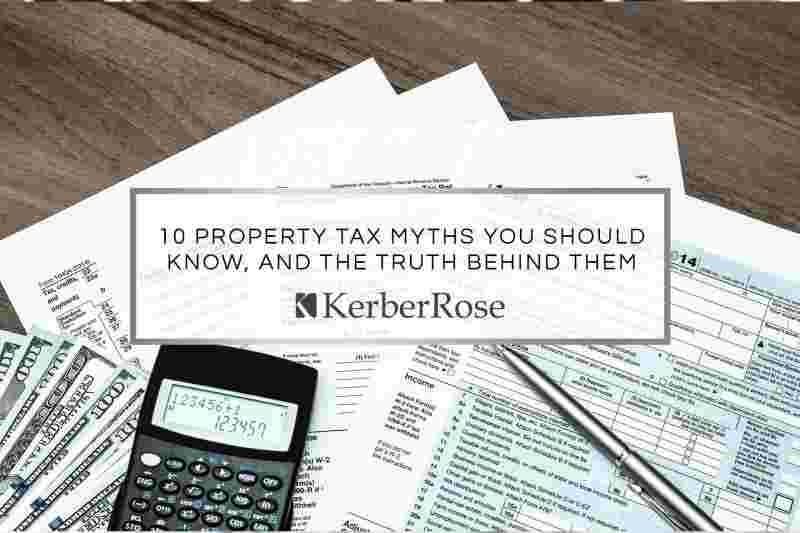10 Property Tax Myths You Should Know, And The Truth Behind Them
Property tax remains one of the largest state and local tax obligations. As homeowners, investors, or aspiring property buyers, understanding the ins and outs of property taxes is crucial for individual empowerment in making financially sound decisions, protecting investments, and planning for a stable financial future.
Nearly all local taxing jurisdictions, including municipalities, counties and boards of education, generate tax revenue through the imposition of property tax, which is one of the most substantial sources of local government revenue. For many businesses, property tax is the largest state and local tax obligation as well as one of the largest regular operating expenses incurred. Unlike other taxes, property tax assessments are based on the estimated value of the property, and thus, are subject to varying opinions. Businesses that fail to take a proactive approach in managing their property tax obligations may be missing an opportunity to reduce their tax liability. Read on to learn more about 10 common property tax myths that you should know, and the truths which counter them.
Personal
MYTH #1: If a property’s value does not increase year to year, the property tax liability should remain the same.
TRUTH: The annual tax rate is determined by the tax levy necessary to fund the applicable governmental budget for services such as schools, libraries, park districts, fire departments and police. Essentially, the governmental budget is divided by the total assessment within a jurisdiction to calculate the tax rate. The tax rate is applied to a property’s individual assessment to calculate tax. Rates can fluctuate annually and can result in higher or lower taxes even if your property value stays consistent.
MYTH #2: Fair market value is equivalent to assessed value.
TRUTH: Fair market value is an estimate of the price at which property would change hands in an arm’s length transaction. The assessed value is a valuation placed on a property by the assessor. Assessed value forms the basis of a property owner’s annual property tax. The assessed value is typically a percentage of the fair market value and takes into account factors such as quality of the property as well as market conditions. Taxpayers should reconcile jurisdictional ratios in order to understand what is considered the fair market value of their property.
MYTH #3: Property tax bills can be appealed.
TRUTH: Unfortunately, you cannot challenge your property’s value once you receive the tax bill. An appeal must be filed within a set window of time after receiving your assessment notice, which in some cases could be a year prior to receiving the tax bill. If an appeal is not filed during the determined period, a taxpayer would have to wait to appeal until the next year’s assessment.
MYTH #4: Obsolescence adjustments do not apply to newer properties.
TRUTH: Property is typically taxed on a value taking into account the ordinary diminishment of value occurring because of factors such as physical wear, age and technological advancements. Obsolescence is an additional form of impairment resulting from internal or external factors affecting value. This includes the functionality of equipment, and processes which inhibit business or external forces impacting financial performance. Regardless of the age of the property, obsolescence factors should be annually reviewed to determine the fair market value of property.
MYTH #5: Assessors establish annual property tax rates.
TRUTH: Property tax rates are set by local governments based on the budget necessary to fund governmental services. Property taxes typically fund city, municipality, county and school district services provided to the community. Assessors determine the value of your property so the tax burden can be distributed. Assessors do not determine the property tax. The amount of tax payable is calculated by the tax rate applied to your property’s assessed value.
MYTH #6: During a property tax audit, the taxpayer’s role is complete once information is provided to the auditor.
TRUTH: Left alone, auditors may make inaccurate or aggressive decisions. They heavily rely on asset listings and balance sheets to determine if items have been appropriately reported. Taxpayers have a lot to gain by staying in contact with auditors throughout the process. Auditors should know the story correlated with the data. Are all assets on the list physically located on property? Are construction in progress (CIP) assets held on site or at a vendor? Is the supplies balance an annual or year-end balance? In the absence of taxpayer direction, auditors may make assumptions based on limited data. Once audit results are finalized, taxpayers can appeal, yet now the burden of proof may have shifted.
MYTH #7: A tenant cannot appeal property taxes.
TRUTH: Tenants may have the ability to directly appeal property values in situations where the owner provides written consent or the lease terms allow the tenant to appeal. Property taxes are typically passed through to the tenants. Therefore, it benefits the tenant to review the annual assessment to determine if an appeal opportunity exists to reduce the property’s assessment.
If your business owns property, you automatically have a property tax obligation. Failure to correctly comply with local property tax laws could result in seizure of property and/or penalties.
MYTH #8: Assessor’s record cards are accurate.
TRUTH: A property record card is a document retained by the assessing jurisdiction, including assessment information about your property used to determine the value. A property record card includes information such as building dimensions, total land acreage, zoning or use of property. It also includes information of construction details and other elements to describe the property. Any discrepancies or outdated information may affect the value of your property. Property owners should obtain their property record cards. This helps to determine the existing errors that need to be corrected and could result in a lower assessment.
MYTH #9: I pay more property tax in jurisdictions taxing both real and personal property.
TRUTH: Property subject to taxation for property tax purposes can vary by jurisdictions. The tax can be imposed on real estate or personal property. All states tax real property, and approximately 38 states tax personal property. Regardless of types of property taxed, the governmental budget will determine the amount of tax needed to fund services. Additionally, it determines the property tax burden will be distributed among taxable values. Therefore, a property owner’s tax liability may be as significant in a jurisdiction only taxing real property.
Corporate
MYTH #10: Reducing my property taxes makes me appear to be a bad corporate citizen.
TRUTH: For many businesses, property taxes are their greatest state and local tax burden. On average, accounts for approximately 38% of the total state and local tax liability. Property owners should ultimately be paying their fair share of property taxes and not more. As property taxes are a cost of doing businesses, certain businesses which overpay may need to make decisions resulting in a reduced workforce. The reductions necessitated by higher tax liabilities may have a more negative impact on the community than ensuring the property taxes remain fair.
Ensure You Make Informed Financial Decisions Moving Forward
Business owners should be aware of their property tax obligations and consider a strategic approach to minimize their tax burden. By understanding the realities behind these misconceptions, investors, homeowners, and property buyers can navigate the complexities of property taxation with confidence. Every individual’s situation is unique, and our Trusted Advisors can provide personalized guidance tailored to your specific needs. We look forward to working with you.
10 Property Tax Myths You Should Know, And The Truth Behind Them
Property tax remains one of the largest state and local tax obligations. As homeowners, investors, or aspiring property buyers, understanding the ins and outs of property taxes is crucial for individual empowerment in making financially sound decisions, protecting investments, and planning for a stable financial future.
Nearly all local taxing jurisdictions, including municipalities, counties and boards of education, generate tax revenue through the imposition of property tax, which is one of the most substantial sources of local government revenue. For many businesses, property tax is the largest state and local tax obligation as well as one of the largest regular operating expenses incurred. Unlike other taxes, property tax assessments are based on the estimated value of the property, and thus, are subject to varying opinions. Businesses that fail to take a proactive approach in managing their property tax obligations may be missing an opportunity to reduce their tax liability. Read on to learn more about 10 common property tax myths that you should know, and the truths which counter them.
Personal
MYTH #1: If a property’s value does not increase year to year, the property tax liability should remain the same.
TRUTH: The annual tax rate is determined by the tax levy necessary to fund the applicable governmental budget for services such as schools, libraries, park districts, fire departments and police. Essentially, the governmental budget is divided by the total assessment within a jurisdiction to calculate the tax rate. The tax rate is applied to a property’s individual assessment to calculate tax. Rates can fluctuate annually and can result in higher or lower taxes even if your property value stays consistent.
MYTH #2: Fair market value is equivalent to assessed value.
TRUTH: Fair market value is an estimate of the price at which property would change hands in an arm’s length transaction. The assessed value is a valuation placed on a property by the assessor. Assessed value forms the basis of a property owner’s annual property tax. The assessed value is typically a percentage of the fair market value and takes into account factors such as quality of the property as well as market conditions. Taxpayers should reconcile jurisdictional ratios in order to understand what is considered the fair market value of their property.
MYTH #3: Property tax bills can be appealed.
TRUTH: Unfortunately, you cannot challenge your property’s value once you receive the tax bill. An appeal must be filed within a set window of time after receiving your assessment notice, which in some cases could be a year prior to receiving the tax bill. If an appeal is not filed during the determined period, a taxpayer would have to wait to appeal until the next year’s assessment.
MYTH #4: Obsolescence adjustments do not apply to newer properties.
TRUTH: Property is typically taxed on a value taking into account the ordinary diminishment of value occurring because of factors such as physical wear, age and technological advancements. Obsolescence is an additional form of impairment resulting from internal or external factors affecting value. This includes the functionality of equipment, and processes which inhibit business or external forces impacting financial performance. Regardless of the age of the property, obsolescence factors should be annually reviewed to determine the fair market value of property.
MYTH #5: Assessors establish annual property tax rates.
TRUTH: Property tax rates are set by local governments based on the budget necessary to fund governmental services. Property taxes typically fund city, municipality, county and school district services provided to the community. Assessors determine the value of your property so the tax burden can be distributed. Assessors do not determine the property tax. The amount of tax payable is calculated by the tax rate applied to your property’s assessed value.
MYTH #6: During a property tax audit, the taxpayer’s role is complete once information is provided to the auditor.
TRUTH: Left alone, auditors may make inaccurate or aggressive decisions. They heavily rely on asset listings and balance sheets to determine if items have been appropriately reported. Taxpayers have a lot to gain by staying in contact with auditors throughout the process. Auditors should know the story correlated with the data. Are all assets on the list physically located on property? Are construction in progress (CIP) assets held on site or at a vendor? Is the supplies balance an annual or year-end balance? In the absence of taxpayer direction, auditors may make assumptions based on limited data. Once audit results are finalized, taxpayers can appeal, yet now the burden of proof may have shifted.
MYTH #7: A tenant cannot appeal property taxes.
TRUTH: Tenants may have the ability to directly appeal property values in situations where the owner provides written consent or the lease terms allow the tenant to appeal. Property taxes are typically passed through to the tenants. Therefore, it benefits the tenant to review the annual assessment to determine if an appeal opportunity exists to reduce the property’s assessment.
If your business owns property, you automatically have a property tax obligation. Failure to correctly comply with local property tax laws could result in seizure of property and/or penalties.
MYTH #8: Assessor’s record cards are accurate.
TRUTH: A property record card is a document retained by the assessing jurisdiction, including assessment information about your property used to determine the value. A property record card includes information such as building dimensions, total land acreage, zoning or use of property. It also includes information of construction details and other elements to describe the property. Any discrepancies or outdated information may affect the value of your property. Property owners should obtain their property record cards. This helps to determine the existing errors that need to be corrected and could result in a lower assessment.
MYTH #9: I pay more property tax in jurisdictions taxing both real and personal property.
TRUTH: Property subject to taxation for property tax purposes can vary by jurisdictions. The tax can be imposed on real estate or personal property. All states tax real property, and approximately 38 states tax personal property. Regardless of types of property taxed, the governmental budget will determine the amount of tax needed to fund services. Additionally, it determines the property tax burden will be distributed among taxable values. Therefore, a property owner’s tax liability may be as significant in a jurisdiction only taxing real property.
Corporate
MYTH #10: Reducing my property taxes makes me appear to be a bad corporate citizen.
TRUTH: For many businesses, property taxes are their greatest state and local tax burden. On average, accounts for approximately 38% of the total state and local tax liability. Property owners should ultimately be paying their fair share of property taxes and not more. As property taxes are a cost of doing businesses, certain businesses which overpay may need to make decisions resulting in a reduced workforce. The reductions necessitated by higher tax liabilities may have a more negative impact on the community than ensuring the property taxes remain fair.
Ensure You Make Informed Financial Decisions Moving Forward
Business owners should be aware of their property tax obligations and consider a strategic approach to minimize their tax burden. By understanding the realities behind these misconceptions, investors, homeowners, and property buyers can navigate the complexities of property taxation with confidence. Every individual’s situation is unique, and our Trusted Advisors can provide personalized guidance tailored to your specific needs. We look forward to working with you.
10 Property Tax Myths You Should Know, And The Truth Behind Them
Property tax remains one of the largest state and local tax obligations. As homeowners, investors, or aspiring property buyers, understanding the ins and outs of property taxes is crucial for individual empowerment in making financially sound decisions, protecting investments, and planning for a stable financial future.
Nearly all local taxing jurisdictions, including municipalities, counties and boards of education, generate tax revenue through the imposition of property tax, which is one of the most substantial sources of local government revenue. For many businesses, property tax is the largest state and local tax obligation as well as one of the largest regular operating expenses incurred. Unlike other taxes, property tax assessments are based on the estimated value of the property, and thus, are subject to varying opinions. Businesses that fail to take a proactive approach in managing their property tax obligations may be missing an opportunity to reduce their tax liability. Read on to learn more about 10 common property tax myths that you should know, and the truths which counter them.
Personal
MYTH #1: If a property’s value does not increase year to year, the property tax liability should remain the same.
TRUTH: The annual tax rate is determined by the tax levy necessary to fund the applicable governmental budget for services such as schools, libraries, park districts, fire departments and police. Essentially, the governmental budget is divided by the total assessment within a jurisdiction to calculate the tax rate. The tax rate is applied to a property’s individual assessment to calculate tax. Rates can fluctuate annually and can result in higher or lower taxes even if your property value stays consistent.
MYTH #2: Fair market value is equivalent to assessed value.
TRUTH: Fair market value is an estimate of the price at which property would change hands in an arm’s length transaction. The assessed value is a valuation placed on a property by the assessor. Assessed value forms the basis of a property owner’s annual property tax. The assessed value is typically a percentage of the fair market value and takes into account factors such as quality of the property as well as market conditions. Taxpayers should reconcile jurisdictional ratios in order to understand what is considered the fair market value of their property.
MYTH #3: Property tax bills can be appealed.
TRUTH: Unfortunately, you cannot challenge your property’s value once you receive the tax bill. An appeal must be filed within a set window of time after receiving your assessment notice, which in some cases could be a year prior to receiving the tax bill. If an appeal is not filed during the determined period, a taxpayer would have to wait to appeal until the next year’s assessment.
MYTH #4: Obsolescence adjustments do not apply to newer properties.
TRUTH: Property is typically taxed on a value taking into account the ordinary diminishment of value occurring because of factors such as physical wear, age and technological advancements. Obsolescence is an additional form of impairment resulting from internal or external factors affecting value. This includes the functionality of equipment, and processes which inhibit business or external forces impacting financial performance. Regardless of the age of the property, obsolescence factors should be annually reviewed to determine the fair market value of property.
MYTH #5: Assessors establish annual property tax rates.
TRUTH: Property tax rates are set by local governments based on the budget necessary to fund governmental services. Property taxes typically fund city, municipality, county and school district services provided to the community. Assessors determine the value of your property so the tax burden can be distributed. Assessors do not determine the property tax. The amount of tax payable is calculated by the tax rate applied to your property’s assessed value.
MYTH #6: During a property tax audit, the taxpayer’s role is complete once information is provided to the auditor.
TRUTH: Left alone, auditors may make inaccurate or aggressive decisions. They heavily rely on asset listings and balance sheets to determine if items have been appropriately reported. Taxpayers have a lot to gain by staying in contact with auditors throughout the process. Auditors should know the story correlated with the data. Are all assets on the list physically located on property? Are construction in progress (CIP) assets held on site or at a vendor? Is the supplies balance an annual or year-end balance? In the absence of taxpayer direction, auditors may make assumptions based on limited data. Once audit results are finalized, taxpayers can appeal, yet now the burden of proof may have shifted.
MYTH #7: A tenant cannot appeal property taxes.
TRUTH: Tenants may have the ability to directly appeal property values in situations where the owner provides written consent or the lease terms allow the tenant to appeal. Property taxes are typically passed through to the tenants. Therefore, it benefits the tenant to review the annual assessment to determine if an appeal opportunity exists to reduce the property’s assessment.
If your business owns property, you automatically have a property tax obligation. Failure to correctly comply with local property tax laws could result in seizure of property and/or penalties.
MYTH #8: Assessor’s record cards are accurate.
TRUTH: A property record card is a document retained by the assessing jurisdiction, including assessment information about your property used to determine the value. A property record card includes information such as building dimensions, total land acreage, zoning or use of property. It also includes information of construction details and other elements to describe the property. Any discrepancies or outdated information may affect the value of your property. Property owners should obtain their property record cards. This helps to determine the existing errors that need to be corrected and could result in a lower assessment.
MYTH #9: I pay more property tax in jurisdictions taxing both real and personal property.
TRUTH: Property subject to taxation for property tax purposes can vary by jurisdictions. The tax can be imposed on real estate or personal property. All states tax real property, and approximately 38 states tax personal property. Regardless of types of property taxed, the governmental budget will determine the amount of tax needed to fund services. Additionally, it determines the property tax burden will be distributed among taxable values. Therefore, a property owner’s tax liability may be as significant in a jurisdiction only taxing real property.
Corporate
MYTH #10: Reducing my property taxes makes me appear to be a bad corporate citizen.
TRUTH: For many businesses, property taxes are their greatest state and local tax burden. On average, accounts for approximately 38% of the total state and local tax liability. Property owners should ultimately be paying their fair share of property taxes and not more. As property taxes are a cost of doing businesses, certain businesses which overpay may need to make decisions resulting in a reduced workforce. The reductions necessitated by higher tax liabilities may have a more negative impact on the community than ensuring the property taxes remain fair.
Ensure You Make Informed Financial Decisions Moving Forward
Business owners should be aware of their property tax obligations and consider a strategic approach to minimize their tax burden. By understanding the realities behind these misconceptions, investors, homeowners, and property buyers can navigate the complexities of property taxation with confidence. Every individual’s situation is unique, and our Trusted Advisors can provide personalized guidance tailored to your specific needs. We look forward to working with you.




